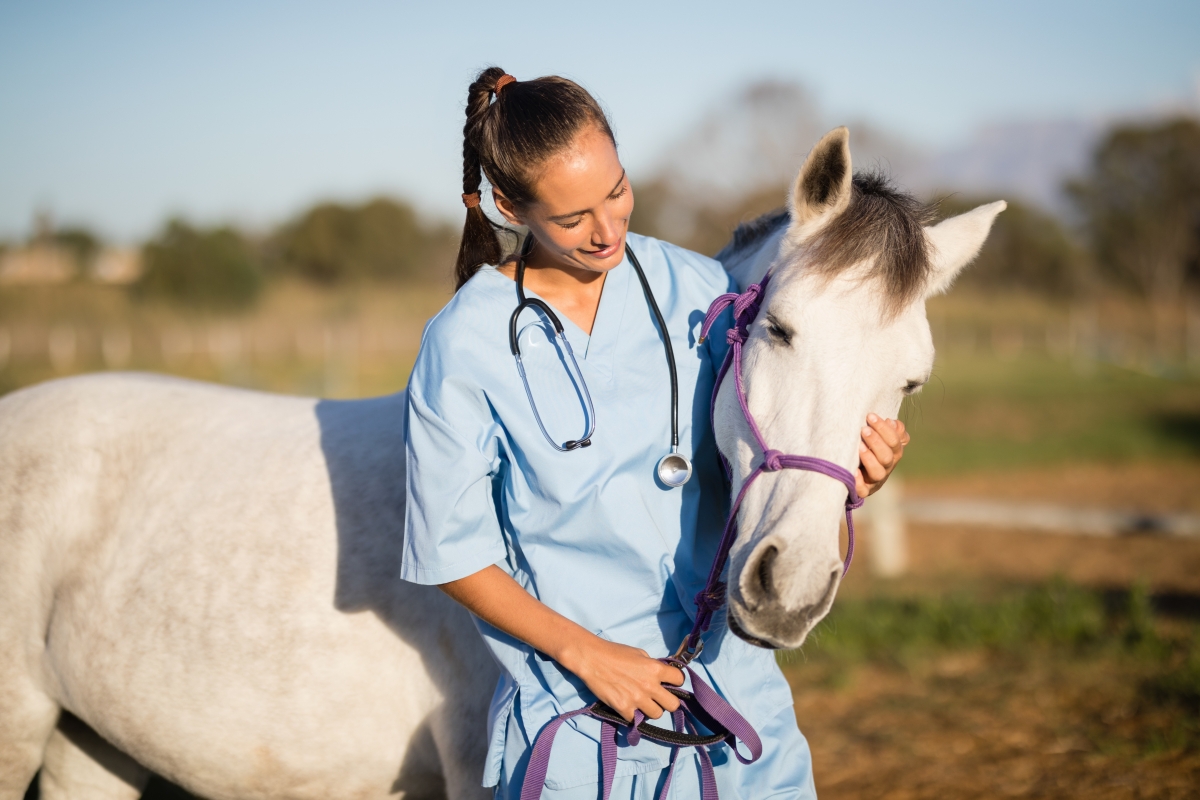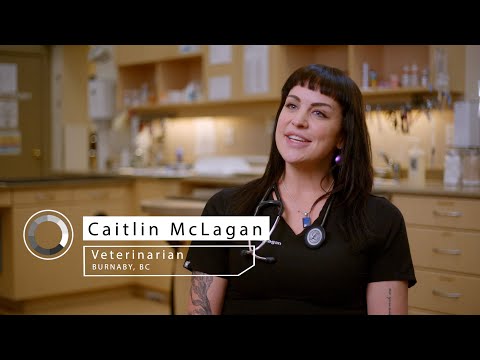Career Overview
Veterinarians prevent, diagnose and treat diseases and disorders in animals and advise clients on the feeding, hygiene, housing and general care of animals. They may work in private practice (animal clinics) or may be employed by laboratories, farms, government or industry.
Job Titles
Duties
In general, veterinarians:
- Identify diseases or abnormal conditions in animals
- Treat sick or injured animals by prescribing medication, setting bones, dressing wounds or performing surgery
- Do routine, emergency and post-mortem examinations
- Vaccinate animals to prevent diseases
- Provide obstetrical and dental services, as well as routine surgeries
- Advise clients on feeding, housing, breeding, hygiene and general care of animals
- Offer euthanasia services
- Play an important role in the monitoring and management of zoonotic diseases (that can jump from animals to humans)
Veterinarians may also:
- Supervise animal health technologists and animal care workers
- Oversee the operation of animal hospitals, clinics or mobile services to farms
- Do veterinary research in areas such as animal nutrition, health care product development and disease prevention and control
- Enforce government regulations in disease control and food production, including through animal or animal-based food inspection
The duties of veterinarians performing research may be similar to those of some biologists.
Earnings
Earnings is income that workers receive in exchange for their labour. Depending on the type of employment, earnings can be in the form of wages (hourly), salaries (fixed monthly or annual) or self-employed earnings.
Work Environment
# Workers Employed
1,490% Employed Full Time
63%Veterinarians generally work in animal hospitals or clinics. Some work may also take place outdoors in a variety of weather conditions. Others work in laboratories or at times from home, if practicing telemedicine.
Animals can be unpredictable and may bite or scratch. Workers may be exposed to infectious bacteria and viruses that may cause illness. Working with equipment and instruments can cause injuries and strong or toxic odours may be present in the workplace.
Career Pathways
Most new graduates pursue jobs in small animal, large animal or mixed practices as an associate veterinarian, working alongside an experienced veterinarian. Some may seek extra training (internships and residencies) to become certified as a specialist in a chosen field of interest, such as surgery, dentistry, radiology or internal medicine.
With experience, a veterinary career can progress into clinic ownership or a senior medical director role in a large corporation. Some veterinarians move away from clinical work and into advisory positions with government, pharmaceutical companies or large corporations.
Occupational Interests
It’s important to understand what kinds of occupations align with your interests.
For more about occupational interests visit Skills for the Future Workforce > Characteristics.
Here are the top occupational interest(s) for this career profile:
Education, Training and Skills
Veterinarians must:
- Complete two years of pre-veterinary university studies or complete a college program in health science
- Complete a four- to five-year university degree in veterinary medicine
- Pass a national certification examination
- Get a provincial licence to practice
Those wishing to specialize in areas such as cardiology, oncology, neurology and other fields must also complete three to four years of additional post-graduate studies or a residency program in the specialty of their choice.
Entry into research positions may require post-graduate study.
Veterinarians who are certified for that occupation by a regulator elsewhere in Canada can apply for the same certification from the regulator in B.C. Under the terms of the Canadian Free Trade Agreement (CFTA), most applicants who are transferring their credentials from elsewhere in Canada will not be required to complete additional training or testing. However, the B.C. regulator may ask applicants to provide further information such as a letter of good standing, references, or criminal record check.
For those trained outside of Canada and never received certification from any Canadian jurisdiction, a full assessment is likely needed. Contact the College of Veterinarians of British Columbia for details on how to apply for certification in B.C.
For information about labour mobility in Canada, visit www.workersmobility.ca.
View a list of Professional Regulatory Authorities in B.C.
Education programs in B.C.

Top Skills
Every job calls for a certain set of skills. Knowing those skills is the first step in finding a good career fit.
Here, you will find the 10 most relevant workplace skills. Some are more important to achieving success in a certain career than others. These skills may come naturally to you or you may need to gain them through education, training and experience.
See the list of work-related skills below, ranked in order of importance for this career. Check out the list and see if this career matches your skills—take that first step!
Understanding written sentences and paragraphs in work-related documents.
Giving full attention to what other people are saying, taking time to understand the points being made, asking questions as appropriate, and not interrupting at inappropriate times.
Using logic and reasoning to identify the strengths and weaknesses of alternative solutions, conclusions or approaches to problems.
Considering the relative costs and benefits of potential actions to choose the most appropriate one.
Being able to solve novel, ill-defined problems in complex, real-world settings.
Understanding how new information could be used to solve current and future problems in making decisions.
Using scientific rules and methods to solve problems.
Talking to others to share information effectively.
Communicating effectively in writing as appropriate for the needs of the audience.
Being aware of others’ reactions and understanding why they react as they do.
Labour Market Statistics
Discover data, facts and information that have been gathered and analyzed. Learn about the characteristics of the economy and labour market in B.C.
Employment
Find out about employment types and trends by region and industry.
Employment
1,490Employment by Region







| Region | Employment | % Employment of this Occupation |
|---|---|---|
| Cariboo | 35 | 2.3% |
| Kootenay | 50 | 3.4% |
| Mainland/Southwest | 800 | 53.7% |
| North Coast and Nechako | 15 | 1.0% |
| Northeast | 10 | 0.7% |
| Thompson-Okanagan | 195 | 13.1% |
| Vancouver Island/Coast | 380 | 25.5% |
Labour Market Outlook
The B.C. Labour Market Outlook is a 10-year forecast of the expected supply and demand for labour in the province. It’s usually updated every year. The purpose is to provide British Columbians with the knowledge to make informed decisions on careers, skills training, education and hiring.
Forecasted Job Openings (2025-2035)
790Forecasted Job Openings
Forecasted Employment Growth Rate
Composition of Job Openings
Job Openings by Region (2025-2035)







| Region | Job Openings | Avg. Annual Employment Growth |
|---|---|---|
| Cariboo | 10 | 0.0% |
| Kootenay | 10 | 0.5% |
| Mainland/Southwest | 370 | 0.9% |
| North Coast and Nechako | 0 | -1.3% |
| Northeast | Not available | Not available |
| Thompson-Okanagan | 120 | 2.5% |
| Vancouver Island/Coast | 280 | 2.4% |
Industry Highlights
Learn about the opportunities in B.C.'s major industries, including employment trends, earning potential, locations of work and more.
Forecasted Job Openings by Industry
| Industry | Job Openings (2025-2035) |
|---|---|
| Professional, Scientific and Technical Services | 750 |
| Public Administration | 40 |
Insights from Industry
With older veterinarians retiring and a shortfall of new graduates, there is significant demand for veterinarians in all fields.
Areas of high demand include veterinarians who serve mixed and large animal practices in rural communities, and veterinary specialists.
Small private practices are in decline as large corporations consolidate the industry.
Resources
-
College of Veterinarians of British Columbia (CVBC)cvbc.ca
-
Canadian Veterinary Medical Association (CVMA)canadianveterinarians.net/index.aspx
-
Canadian Veterinary Medical Association – B.C. Chapterwww.canadianveterinarians.net/sbcv/cvma-sbcv-overview/
-
Canadian Veterinary Medical Association – B.C. Chapter, Careerswww.canadianveterinarians.net/sbcv/classified-ads/
-
American Association of Veterinary Medical Colleges (AAVMC)www.aavmc.org
-
Western Canadian Association of Bovine Practitioners (WCABP)www.wcabp.com
-
Canadian Food Inspection Agencywww.inspection.gc.ca








